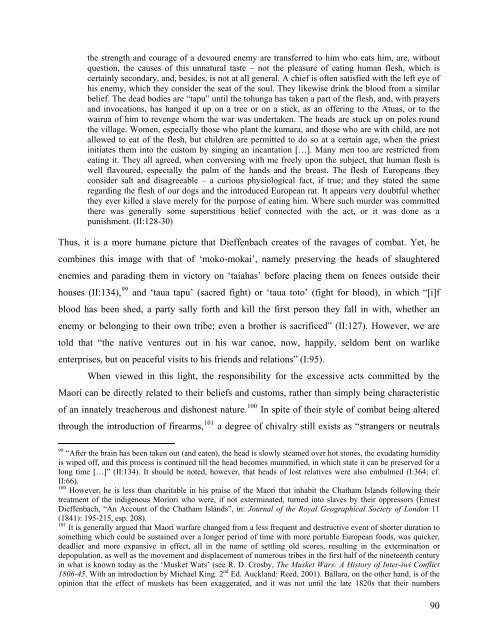General copyright and disclaimer - ResearchSpace@Auckland ...
General copyright and disclaimer - ResearchSpace@Auckland ...
General copyright and disclaimer - ResearchSpace@Auckland ...
Create successful ePaper yourself
Turn your PDF publications into a flip-book with our unique Google optimized e-Paper software.
the strength <strong>and</strong> courage of a devoured enemy are transferred to him who eats him, are, without<br />
question, the causes of this unnatural taste – not the pleasure of eating human flesh, which is<br />
certainly secondary, <strong>and</strong>, besides, is not at all general. A chief is often satisfied with the left eye of<br />
his enemy, which they consider the seat of the soul. They likewise drink the blood from a similar<br />
belief. The dead bodies are “tapu” until the tohunga has taken a part of the flesh, <strong>and</strong>, with prayers<br />
<strong>and</strong> invocations, has hanged it up on a tree or on a stick, as an offering to the Atuas, or to the<br />
wairua of him to revenge whom the war was undertaken. The heads are stuck up on poles round<br />
the village. Women, especially those who plant the kumara, <strong>and</strong> those who are with child, are not<br />
allowed to eat of the flesh, but children are permitted to do so at a certain age, when the priest<br />
initiates them into the custom by singing an incantation […]. Many men too are restricted from<br />
eating it. They all agreed, when conversing with me freely upon the subject, that human flesh is<br />
well flavoured, especially the palm of the h<strong>and</strong>s <strong>and</strong> the breast. The flesh of Europeans they<br />
consider salt <strong>and</strong> disagreeable – a curious physiological fact, if true; <strong>and</strong> they stated the same<br />
regarding the flesh of our dogs <strong>and</strong> the introduced European rat. It appears very doubtful whether<br />
they ever killed a slave merely for the purpose of eating him. Where such murder was committed<br />
there was generally some superstitious belief connected with the act, or it was done as a<br />
punishment. (II:128-30)<br />
Thus, it is a more humane picture that Dieffenbach creates of the ravages of combat. Yet, he<br />
combines this image with that of ‘moko-mokai’, namely preserving the heads of slaughtered<br />
enemies <strong>and</strong> parading them in victory on ‘taiahas’ before placing them on fences outside their<br />
houses (II:134), 99 <strong>and</strong> ‘taua tapu’ (sacred fight) or ‘taua toto’ (fight for blood), in which “[i]f<br />
blood has been shed, a party sally forth <strong>and</strong> kill the first person they fall in with, whether an<br />
enemy or belonging to their own tribe; even a brother is sacrificed” (II:127). However, we are<br />
told that “the native ventures out in his war canoe, now, happily, seldom bent on warlike<br />
enterprises, but on peaceful visits to his friends <strong>and</strong> relations” (I:95).<br />
When viewed in this light, the responsibility for the excessive acts committed by the<br />
Maori can be directly related to their beliefs <strong>and</strong> customs, rather than simply being characteristic<br />
of an innately treacherous <strong>and</strong> dishonest nature. 100 In spite of their style of combat being altered<br />
through the introduction of firearms, 101 a degree of chivalry still exists as “strangers or neutrals<br />
99 “After the brain has been taken out (<strong>and</strong> eaten), the head is slowly steamed over hot stones, the exudating humidity<br />
is wiped off, <strong>and</strong> this process is continued till the head becomes mummified, in which state it can be preserved for a<br />
long time […]” (II:134). It should be noted, however, that heads of lost relatives were also embalmed (I:364; cf.<br />
II:66).<br />
100 However, he is less than charitable in his praise of the Maori that inhabit the Chatham Isl<strong>and</strong>s following their<br />
treatment of the indigenous Moriori who were, if not exterminated, turned into slaves by their oppressors (Ernest<br />
Dieffenbach, “An Account of the Chatham Isl<strong>and</strong>s”, in: Journal of the Royal Geographical Society of London 11<br />
(1841): 195-215, esp. 208).<br />
101 It is generally argued that Maori warfare changed from a less frequent <strong>and</strong> destructive event of shorter duration to<br />
something which could be sustained over a longer period of time with more portable European foods, was quicker,<br />
deadlier <strong>and</strong> more expansive in effect, all in the name of settling old scores, resulting in the extermination or<br />
depopulation, as well as the movement <strong>and</strong> displacement of numerous tribes in the first half of the nineteenth century<br />
in what is known today as the ‘Musket Wars’ (see R. D. Crosby, The Musket Wars: A History of Inter-iwi Conflict<br />
1806-45. With an introduction by Michael King. 2 nd Ed. Auckl<strong>and</strong>: Reed, 2001). Ballara, on the other h<strong>and</strong>, is of the<br />
opinion that the effect of muskets has been exaggerated, <strong>and</strong> it was not until the late 1820s that their numbers<br />
90















